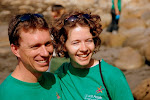
In coming to Los Cabos, we wanted to show the cast more than just the beautiful vacation community full of wealthy snowbirds that move south to spend their winters here. Part of the goal of our sponsor, the Los Cabos Children’s Foundation, was to educate the local Mexican community that lives and works here year-round about the services and support that the foundations partner agencies offer. So we were taken by the director of Ligamac, which is an agency that helps children get school supplies and uniforms so they can attend school, to a very poor, newer community on the outskirts of Cabo San Jose. In recent years, there has been a huge migration to Cabo because of the construction demand. But families are moving here too quickly for the community infrastructure, so there isn’t enough housing or schools or sewers or roads to handle the influx. As a result, there are squatter communities popping up in the desert outside of town, where homes are made of plywood and scrap metal, and in some cases are put up the dry riverbeds, where a strong storm can wash away an entire community overnight.
It was hard for the cast to drive our air-conditioned shiny coach buses into this community, to get out for less than an hour, to walk around, talk with the families living there, to play with the kids, and to learn a little bit about these people and their situation. To some it looked so bleak, yet there were small gardens, and homes that were well-cared for, and in the more established community, where most families have been there for a year or more, there are structures of cement with rebar sticking out the top as a sign of the 2nd floor addition that they’re planning as more money comes in. That’s what is incredible about the way this community is developing—its not that a big development company comes in and builds a complex, and then the families move into bright, finished suburbia. It’s one family at a time, building their houses from scraps that the husband brings back from the fancy condo construction site he works on all day, if he’s lucky enough to have found work. Every house has a water tank, and a truck drives through the community delivering water, house by house. It isn’t potable, so another truck delivers drinking water. Schools are overflowing and for many, the nearest one is over an hour’s walk away.
 But as we talked to the women and played with the children in this dry, dusty village, they expressed their appreciation for us coming, and being interested in learning about their situation. So even though it feels horrible to get off the buses and take pictures—I heard comments about cast members not wanting to treat these people like we were at a zoo- but if we had ignored it altogether by not coming, and instead have only had the more touristy Cabo experience, we wouldn’t be doing the community justice either. And in visiting the community with one of our beneficiary partners who works with these people every day, it was an honor for us to see what the money raised from our show will benefit.
But as we talked to the women and played with the children in this dry, dusty village, they expressed their appreciation for us coming, and being interested in learning about their situation. So even though it feels horrible to get off the buses and take pictures—I heard comments about cast members not wanting to treat these people like we were at a zoo- but if we had ignored it altogether by not coming, and instead have only had the more touristy Cabo experience, we wouldn’t be doing the community justice either. And in visiting the community with one of our beneficiary partners who works with these people every day, it was an honor for us to see what the money raised from our show will benefit.
The irony was that we started the day in this poor, depressed community, and then visited a lush mango farm in the rain where we hurriedly hiked to a waterfall and rode back to the buses in pickup trucks full of mangos, with fresh mango juice dribbling from our chins. We had to rush back to Cabo in order to make our sunset boat cruise out to the famous Cabo arch. On the boat there was a band and an open bar, and we danced and ate sushi and saw sea lions, and had a wonderful, amazing time… all the while remembering the families we met this morning and how different our lives were from theirs. It was a day of huge contrasts, and one that this cast will not soon forget.
 It was such a beautiful ride where we saw some nesting birds, a crocodile and some beautiful landscape. We stopped at a crocodile breeding area, where they are working to maintain a healthy crocodile population in the area.
It was such a beautiful ride where we saw some nesting birds, a crocodile and some beautiful landscape. We stopped at a crocodile breeding area, where they are working to maintain a healthy crocodile population in the area. 








